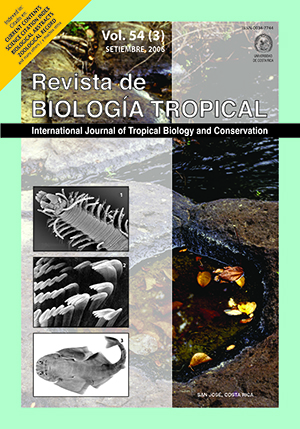Abstract
In the dry forest of Santa Rosa National Park, Costa Rica, the understory shrub Jacquinia nervosa presents an inverse pattern of phenology that concentrates vegetative growth and reproduction during the dry season. In this study, we tested the “escape from herbivory” hypothesis as a potential explanation for the inverse phenological pattern of J. nervosa. We monitored leaf, flower and fruit production in 36 adult plants from October 2000 to August 2001. Leaves of six randomly selected branches per plant were marked and monitored every two weeks to measure the cumulative loss in leaf area. To analyze pre-dispersal seed predation we collected 15 fruits per plant and counted the total number of healthy and damaged seeds, as well as the number and type of seed predators found within the fruits. Leaf, flower, and fruit production occurred during the first part of the dry season (end of November to February). The cumulative herbivory levels were similar to those observed in other tropical dry forest tree species that concentrate leaf production during the wet season, and were concentrated on young leaves, which lost an average of 36.77 % of their area (SD= 34.35 %, N= 195). Chewing beetles of the genus Epicauta (Meloidae) were the most important herbivores. In mature leaves, most of the damage was caused by the beetle Coptocycla rufonotata (Chrysomelidae). Fruits took 4 months to develop during the dry season (January-March 2001) but continue increasing in size well into the first 3 months of the wet season (May-July). Average seed number per ripe fruit was 9 (SD = 5, N = 500). Seed predation in mature fruits was 42 % (SD = 47 %, N = 122). Most seeds were damaged by moth larvae of the family Tortricidae. Only 3 % of the flowers became fruits. This was influenced by the low level of flower synchrony (0.38±0.26, N = 36 plants), but neither leaf synchrony (0.88±0.06, N = 36 plants) nor plant size influenced fruit numbers. The significant damaged produced by insect herbivores in young leaves, fruits, and seeds, as well as the low reproductive index observed in J. nervosa, shows that the inverse leafing phenology of this species is not consistent with the “escape hypothesis” since J. nervosa was considerably attacked during the dry season. Considering the strong seasonality of the tropical dry forest and the heliophyte character of J. nervosa, it is more likely that this phenological strategy evolved in response to seasonal fluctuations in light availability, light quality, and daylength.Comments

This work is licensed under a Creative Commons Attribution 4.0 International License.
Copyright (c) 2006 Revista de Biología Tropical
Downloads
Download data is not yet available.






